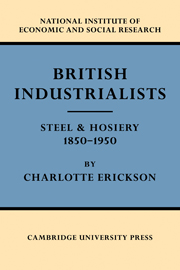Book contents
- Frontmatter
- Contents
- LIST OF TABLES
- Foreword
- Introduction
- I SCOPE OF THE INQUIRY
- II SOCIAL ORIGINS OF THE STEEL MANUFACTURERS
- III CAREERS OF THE STEEL MANUFACTURERS
- IV SOCIAL ORIGINS OF THE NOTTINGHAM HOSIERS
- V CAREERS OF THE HOSIERY MANUFACTURERS
- VI THE INTRODUCTION OF NEW TECHNIQUES IN STEEL-MAKING
- VII HOSIERY INNOVATORS
- VIII THE PUBLIC COMPANY
- Appendix A Selection of firms
- Appendix B List of firms included in steel study
- Appendix C Selection of men for steel study
- Appendix D The hosiery samples
- Appendix E Classification of fathers' occupations
- Appendix F Notes on comparisons with Population Census
- Appendix G Education
- Appendix H Marriages
- Appendix I Careers
- Appendix J Public company tables
- List of Principal Works Cited
- Index of names
- Index of companies
- General index
- PUBLICATIONS OF THE NATIONAL INSTITUTE OF ECONOMIC AND SOCIAL RESEARCH
II - SOCIAL ORIGINS OF THE STEEL MANUFACTURERS
Published online by Cambridge University Press: 07 October 2011
- Frontmatter
- Contents
- LIST OF TABLES
- Foreword
- Introduction
- I SCOPE OF THE INQUIRY
- II SOCIAL ORIGINS OF THE STEEL MANUFACTURERS
- III CAREERS OF THE STEEL MANUFACTURERS
- IV SOCIAL ORIGINS OF THE NOTTINGHAM HOSIERS
- V CAREERS OF THE HOSIERY MANUFACTURERS
- VI THE INTRODUCTION OF NEW TECHNIQUES IN STEEL-MAKING
- VII HOSIERY INNOVATORS
- VIII THE PUBLIC COMPANY
- Appendix A Selection of firms
- Appendix B List of firms included in steel study
- Appendix C Selection of men for steel study
- Appendix D The hosiery samples
- Appendix E Classification of fathers' occupations
- Appendix F Notes on comparisons with Population Census
- Appendix G Education
- Appendix H Marriages
- Appendix I Careers
- Appendix J Public company tables
- List of Principal Works Cited
- Index of names
- Index of companies
- General index
- PUBLICATIONS OF THE NATIONAL INSTITUTE OF ECONOMIC AND SOCIAL RESEARCH
Summary
The modern steel industry is just a hundred years old. When Henry Bessemer read his famous paper at Cheltenham in September 1856 he had solved, admittedly, the engineering rather than the metallurgical problems of steel-making in a converter. Within three years enough progress had been made on these metallurgical problems to make steel commercially in the Bessemer converter. Less than ten years later the open-hearth process was also producing steel in Britain. These innovations took place during a period of unprecedented prosperity when profits were high for both industry and agriculture.
We are to examine the social origins of steel manufacturers over a century during which, in broad terms, the industry and the British economy descended from a peak of leadership at which Britain was truly the workshop of the world. During the years of the so-called ‘Great Depression’ in the last quarter of the century the American and German steel industries were beginning to challenge British leadership. Although the new century opened with a burst of deceptive prosperity, heightened by the First World War, the inter-war years reduced the British industry to a state of severe crisis as world demand shrank and basic steel, of which Britain was only just becoming a major producer, claimed more and more of existing markets.
- Type
- Chapter
- Information
- British IndustrialistsSteel and Hosiery 1850–1950, pp. 9 - 49Publisher: Cambridge University PressPrint publication year: 1959



